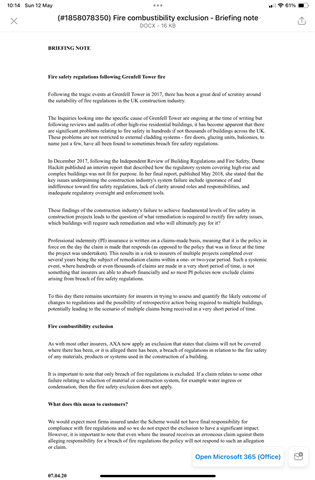This morning I had at look at my renewal quote for my Electrical Contractors combined insurances policy.
Attached is a briefing note from the insurance company, regarding a Fire Combustibility Exclusion Clause. Any thoughts?

This morning I had at look at my renewal quote for my Electrical Contractors combined insurances policy.
Attached is a briefing note from the insurance company, regarding a Fire Combustibility Exclusion Clause. Any thoughts?

AFDDs should probably be a direct question to AXA or whoever your insurer is for clarification - This is a more general notice and seems to be more about building regs and how things burn in a fire (combustibility) and while the AFFDs probably do burn, no more than an MCB of the same size.
More immediately for electricians the prospect of less insurance cover should have a chilling effect on the folk busy drilling holes in double plasterboard ceilings for trendy lights, and removing and not replacing the fire stopping in trunking that carries cables between partitions in a building.
PVC trunking instead of metal overhead over the exit doors anyone ? I can already see a move away from PVC, and given how horrible it is when it burns, it can't come soon enough.
The main building reg for fire is part B and I suspect primarily the insurers are not wanting to cover claims against builders who have compromised fire safety (flammable fixtures or cladding perhaps) or fail to provide correct escape routes or the right sort of fire doors - an issue that seems to be very common if the reports are to be believed.
Given how much has not been spotted in the past It also makes you wonder if building control are up to the task ahead of them with even more to check for.
Mike.
I think this is just a general statement for fire and combustible materials. It does make me wonder what they (insurance Industry) are working on in the background. I have seem many a building fabric penetration where no fire seal/firemate (other brands are available) was used. Could BS7671 see a Mandatory introduction for fire suppression in CU/DB something like Envirograf EnviroBurst (other brands are available)? Will LS0H become the norm for domestic dwellings?
Thank you for pointing this out Sparkingchip.
If this applies across the board, it effectively means that clients are not protected should they wish to pursue claims against the PI insurance of designers/contractors that fail to meet “fire safety regulations”. Similarly, designers/contractors are not covered should such a claim be made.
I am on holiday at the moment but since the design and specification of fire safety measures is my bread and butter, I will have to thoroughly check my own PI insurance arrangements.
My reading of this is that it is a hugely significant issue for the construction industry for designers, contractors and clients alike. Paradoxically, it may mean better fire safety in that clients will have to be especially careful that project proposals are watertight in terms of fire safety compliance and appropriate oversight is in place during the construction phase to ensure those fire safety measures proposed are properly implemented.
My reading of this is that it is a hugely significant issue for the construction industry for designers, contractors and clients alike.
A quick Google shows that it is. For example (but there's loads more like this):
https://www.designingbuildings.co.uk/wiki/Fire_safety_exclusions_-_the_insurance_position
Whilst looking around I found one authoritative site that said that it's likely that designers, consultants etc may have to write into their contracts that it is the client's responsibility to employ a Fire Risk Surveyor (I may have got the term wrong), on the grounds that only such a person would be in a position to take the risk and get (afford) appropriate insurance. Annoying I can't find that site again now. And of course not much help for small domestic work.
Regards it being the clients responsibility to appoint a fire risk assessor, here is a comment in an IET Wiring Matters article about the BS7671 corrigendum issued last year and escape routes:
It is important to note that the fire strategy and fire engineering requirements are the responsibility of a fire engineer. It is not the job for an electrician to determine which areas are considered protected escape routes or not. Professional advice from a fire engineer should be sought.
Presumably, unless they can get insurance, very few will be happy to step into a fire risk assessor/advisor role if it means carrying the can for omissions in a design/ construction of something you cannot see in totality - which may be the case for most projects on existing buildings. Which may risk leaving only the cowboy types in operation.
I also wonder where it leaves the £50 drive-by EICR. Should fire stops be checked at the same time ?
Mike
We're about to take you to the IET registration website. Don't worry though, you'll be sent straight back to the community after completing the registration.
Continue to the IET registration site